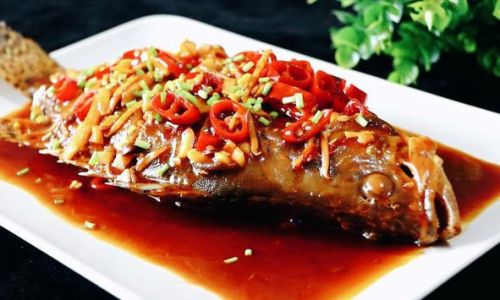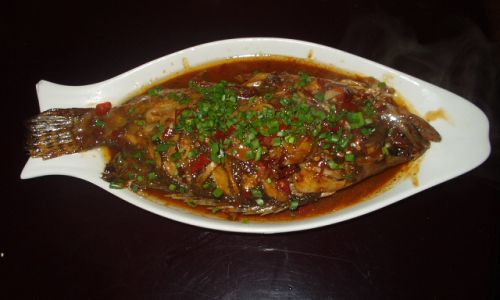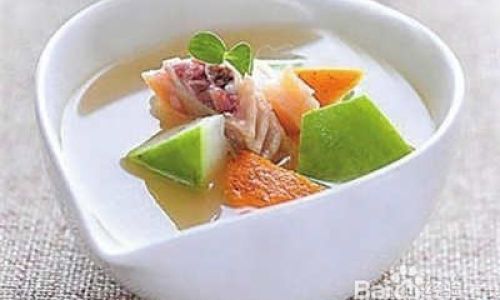Introduction
In the vast culinary landscape of China, traditional preservation techniques have played a pivotal role in transforming simple ingredients into culinary delights that transcend time and space. Among these timeless delicacies, salted fresh mandarin fish (Guiyu in Chinese) stands out as a testament to the harmony between nature’s bounty and human ingenuity. This dish, characterized by its unique flavor profile and texture, is a cherished part of Anhui cuisine, where it is known as “xiang gui yu” (fragrant mandarin fish). This article delves into the intricate process of preparing salted fresh mandarin fish, from selecting the perfect fish to the final cooking stages, revealing the secrets behind its enchanting taste.
Selecting the Mandarin Fish
The journey of crafting salted fresh mandarin fish begins with careful selection of the fish itself. Mandarin fish (Siniperca chuatsi), also known as the Chinese perch, is a freshwater species renowned for its delicate flesh, firm texture, and rich flavor. When choosing a mandarin fish for salting, one must look for fish that are fresh, firm to the touch, with clear eyes and bright, silvery scales. The ideal size ranges between one and two kilograms, as this ensures even salting and a balanced cooking time.
It’s crucial to source the fish from reputable suppliers or directly from local fisheries to guarantee freshness. Once the fish is caught, it should be gutted, scaled, and cleaned promptly to prevent spoilage. This initial step is vital as it sets the foundation for the entire preservation and cooking process.

The Salting Process
The salting of mandarin fish is a delicate balance of salt, time, and temperature. The traditional method involves using coarse sea salt, which not only preserves the fish but also enhances its natural flavors. Here’s a step-by-step guide to the salting process:
-
Preparation: Begin by rinsing the cleaned fish thoroughly under cold running water to remove any traces of blood or internal organs. Pat the fish dry using a clean cloth to ensure that the salt adheres evenly.
-
Salting: Spread a layer of coarse sea salt on the bottom of a large, clean ceramic or glass jar. Place the fish inside, skin side down, and sprinkle a generous amount of salt over its flesh. Rub the salt gently into the fish, ensuring all surfaces are evenly coated. Repeat this process for the second side, placing the fish skin side up this time. Add a final layer of salt on top of the fish.
-
Weighting Down: To prevent the fish from floating and ensure even salting, place a heavy object, such as a clean stone or a weighted plate, on top of the fish. This keeps the fish submerged in its own juices and the salt, facilitating the osmosis process.
-
Curing: Cover the jar with a tight-fitting lid and store it in a cool, dark place. The ideal temperature for curing is between 4-10°C (39-50°F). The curing time can vary depending on the size of the fish and personal preference, but it typically ranges from three to seven days. During this period, the salt draws out moisture from the fish, preserving it while developing a unique flavor.

-
Rinsing and Drying: After the curing period, remove the fish from the jar and rinse off the excess salt under cold water. Pat the fish dry with a clean cloth and let it air-dry on a rack for a few hours. This step helps to firm up the flesh and concentrate the flavors.
Storage
Once the fish has been salted, rinsed, and dried, it can be stored in several ways:
- Refrigeration: Wrap the fish tightly in plastic wrap or store it in an airtight container and place it in the refrigerator. It will keep for several weeks.
- Freezing: For longer-term storage, wrap the fish securely and freeze it. Properly frozen, salted fresh mandarin fish can be kept for several months.
- Traditional Drying: In some regions, the fish is further dried in the sun or by using a food dehydrator to create a dried, almost jerky-like texture. This extends its shelf life even further.
Cooking Salted Fresh Mandarin Fish
The cooking of salted fresh mandarin fish can vary widely, from steaming to braising, frying, or even incorporating it into soups and stews. Here are three classic cooking methods:
Steamed Salted Fresh Mandarin Fish

- Ingredients: Salted fresh mandarin fish, ginger slices, green onions, soy sauce, sesame oil, chili oil (optional), and rice vinegar (optional).
- Preparation: Place the fish on a steaming plate lined with ginger slices and green onions. Steam over boiling water for about 15-20 minutes, depending on the thickness of the fish. Remove and garnish with chopped green onions, drizzle with soy sauce, sesame oil, and chili oil if desired. Serve hot with a side of rice vinegar for an extra layer of flavor.
Braised Salted Fresh Mandarin Fish with Soy Sauce
- Ingredients: Salted fresh mandarin fish, soy sauce, sugar, ginger slices, garlic cloves, cooking wine, water, and green onions.
- Preparation: In a pot, combine soy sauce, sugar, ginger, garlic, cooking wine, and enough water to cover the fish halfway. Bring to a boil, then gently lower the fish into the pot. Reduce the heat to a simmer, cover, and cook for about 20-30 minutes, turning the fish halfway through. Serve garnished with green onions.
Pan-Fried Salted Fresh Mandarin Fish with Chili Sauce
- Ingredients: Salted fresh mandarin fish, cornstarch, vegetable oil, garlic cloves, chili sauce (such as Sichuan peppercorn sauce), and green onions.
- Preparation: Pat the fish dry thoroughly. Dust it lightly with cornstarch to create a crispy coating. Heat vegetable oil in a pan over medium-high heat. Fry the fish until golden brown on both sides, about 5-7 minutes per side. Remove the fish and set aside. In the same pan, sauté garlic until fragrant, then add chili sauce and a splash of water. Cook until thickened, then pour over the fried fish. Garnish with green onions and serve.
Conclusion
Salted fresh mandarin fish is a culinary gem that embodies the essence of traditional Chinese food preservation and cooking. Its preparation, from meticulous selection of the fish to the careful balance of salting and cooking techniques, requires patience, skill, and a deep respect for the ingredients. Each step in the process contributes to the final dish’s unique flavor and texture, making it a cherished delicacy that transcends generations.
Whether enjoyed as a simple steamed dish, braised in a rich soy sauce, or pan-fried with a spicy chili glaze, salted fresh mandarin fish offers a taste of China’s rich culinary heritage. Its preparation is not merely a cooking task but an art form, one that connects the past with the present, and invites diners to savor the timeless beauty of preserved and cooked fish at its finest.





0 comments